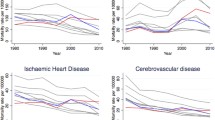Abstract
Aim
The aim of the study was to evaluate the impact of occupation, family status, and smoking on overall mortality in males in Germany.
Subjects and methods
This study used data from a longitudinal register of the “Gmuender Ersatzkasse” (GEK), a German health insurance fund, for the time period between January 1989 and December 2000. Included in the analysis were male members of the GEK who were employed on 1 January 1989 and who were born between 1935 and 1950. Only those occupations were considered for which the frequency exceeded 1,000 cases. Thus, 17 occupations comprising 80,716 individuals were included. The statistical analysis was performed utilizing the software package “Transitional Data Analysis” (TDA) and employing the Kaplan-Meier life-table approach and a multivariate survival analysis applying the Cox regression method.
Results
Statistically increased relative risks for total mortality were observed for non-married persons, for the four main occupational groups with a lower status, for 13 occupations with medium or lower status, and for occupations yielding a smoking prevalence rate of 40% and more.
Conclusions
Longitudinal data from health insurance funds in Germany provide a valuable resource for social epidemiological investigations. The findings suggest that the occupational setting has a strong impact on overall mortality experience in Germany.


Similar content being viewed by others
References
Berkman LF, Syme SL (1979) Social networks, host resistance and mortality: a nine-year follow-up study of Alameda Country residents. Am JEpidemiol 109:186–204
Blossfeld HP (1989) Kohortendifferenzierung und Karriereprozeß Eine Längsschnittstudie über die Veränderung der Bildungs- und Berufschancen im Lebensverlauf. Frankfurt/Main, Campus
Blossfeld HP, Rohwer G (2002) Techniques of event history modeling. New approaches to causal analysis, 2nd edn. Lawrence Erlbaum, Mahwah
Davey Smith G (2003) Health inequalities: lLife course approaches. Studies in poverty, inequality and social exclusion. Policy Press, Bristol
Diderichsen F, Hallqvist J (1997) Trends in occupational mortality among middle-aged men in Sweden 1961–1990. Int J Epidemiol 26:782–787
Doll R (2000) Fifty years of research on tobacco. J Epidemiol Biostat 5:321–329
Geyer S, Peter R (1999) Occupational status and all-cause mortality: a study with health insurance data from Nord Rhein-Westfalen, Germany. Eur J Public Health 9:119–123
Helmert U (2003) Soziale Ungleichheit und Krankheitsrisiken. Maro, Augsburg
Helmert U, Borgers D (1998) Rauchen und Beruf. Eine Analyse von 100 000 Befragten des Mikrozensus 1995. Bundesgesundheitsblatt 41:102–107
Helmert U, Shea S, Bammann K (1997) The impact of occupation on self-reported cardiovascular morbidity in Western Germany: gender differences. Rev Environ Health 12:25–42
Helmert U, Shea S, Bammann K (1999) Social correlates of cigarette-smoking cessation. Rev Environ Health 14:239–250
Huber L, Hebel D, Stahl R (1998) 120 Jahre GEK. Eberle, Schwäbisch Gmünd
Hu Y, Goldman N (1990) Mortality differentials by marital status: an international comparison. Demography 27:233–250
Kaplan EL, Meier P (1958) Nonparametric estimation from incomplete observations. J Am Stat Assoc 53:457–481
Klein T (1993) Soziale Determinanten der Lebenserwartung. Kölner Z Soziol Sozialpsychol 45:712–730
Klosterhuis H, Müller-Fahrnow W (1994) Sozialschicht und Sterblichkeit bei männlichen Angestellten aus den alten Bundesländern. In: Mielck A (ed) Krankheit und soziale Ungleichheit. Ergebnisse der sozialepidemiologischen Forschung in Deutschland. Leske und Budrich, Opladen, pp 319–330
Kunst AE (1997) Cross-national comparisons of socio-economic differences in mortality. Erasmus University, Rotterdam
Kunst AE, Groenhof F, Mackenbach JP, EU Working Group on Socioeconomic Inequalities in Health (1998) Occupational class and cause specific mortality in middle aged men in 11 European countries: comparison of population based studies. BMJ 316:1636–1642
Lahelma E, Arber S (1994) Health inequalities among men and women in contrasting welfare states. Britain and three Nordic countries compared. Eur J Public Health 4:213–226
Mackenbach JP, Kunst AE, Cavalaars AEJM, Groenhof F, Geurts JJM, EU Working Group on Socioeconomic Inequalities in Health (1997) Socioeconomic inequalities in morbidity and mortality in Western Europe. Lancet 349:1655–1659
Mackenbach JP, Kunst AE, Groenhof F, Borgan JK, Costa G, Faggiano F, Jozan P, Leinsalu M, Martikainen P, Rychtarikova J, Valkonen T (1999) Socioeconomic inequalities in mortality among women and among men: an international study. Am J Public Health 89:1800–1806
Mackenbach JP, Bos V, Andersen O, Cardano M, Costa G, Herding S, Reid A, Hemström Ö, Valkonen T, Kunst AE (2003) Widening socioeconomic inequalities in mortality in six Western European countries. Int J Epidemiol 32:830–837
Marmot M, Wilkinson RG (1999) Social determinants of health. Oxford University Press, Oxford
Mielck A, Giraldes MR (1993) Inequalities in health and health care. Review of selected publications from 18 Western Europe countries. Waxman, Muenster
Neumann G, Liedermann A (1981) Mortalität und Sozialschicht. Bundesgesundheitsblatt 24:173–181
Peto R, Lopez AD, Boreham J, et al (1992) Mortality from tobacco in developed countries: indirect estimation from national vital statistics. Lancet 339:1268–1278
Rosenbrock R (2001) Der neue § 20 SGB V als Gestaltungsherausforderung für die Selbstverwaltung der GKV. Die Betriebskrankenkasse 20:12–17
Sorlie PD, Backlund E, Keller JB (1995) U.S. mortality by economic, demographic, and social characteristics: the National Longitudinal Mortality Study. Am Journal Public Health 85:949–956
Statistisches Bundesamt (1992) Klassifizierung der Berufe. Abgeleitete Fassung für Zwecke des Mirkozensus und der EG-Arbeitskräftestichprobe, Wiesbaden
Valkonen T (1998) Die Vergrößerung der sozioökonomischen Unterschiede in der Erwachsenenmortalität durch Status und deren Ursachen. Z Bevölkerungswis 23:263–292
Author information
Authors and Affiliations
Corresponding author
Rights and permissions
About this article
Cite this article
Helmert, U. The impact of occupation and family status on overall mortality in a cohort of male members of a health insurance fund in Germany. J Public Health 13, 138–143 (2005). https://doi.org/10.1007/s10389-005-0100-7
Received:
Accepted:
Published:
Issue Date:
DOI: https://doi.org/10.1007/s10389-005-0100-7




